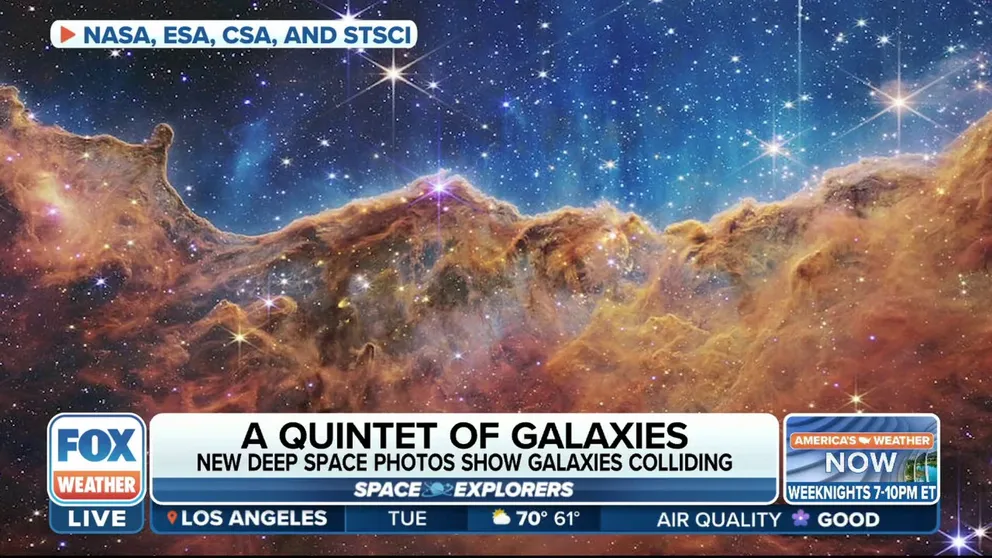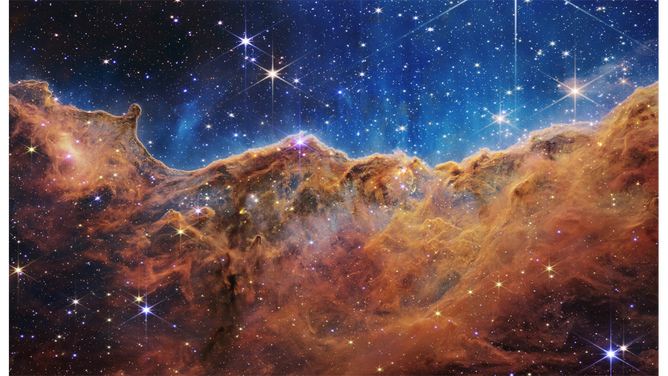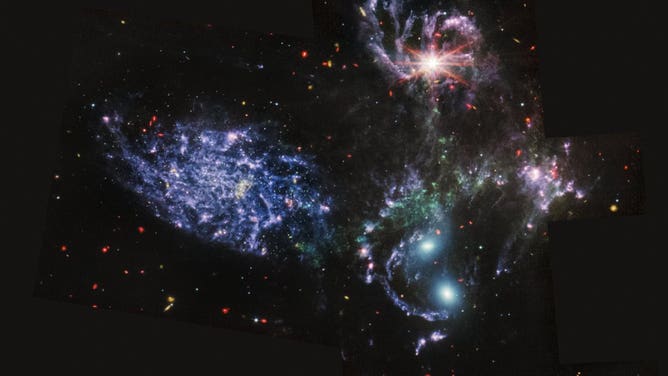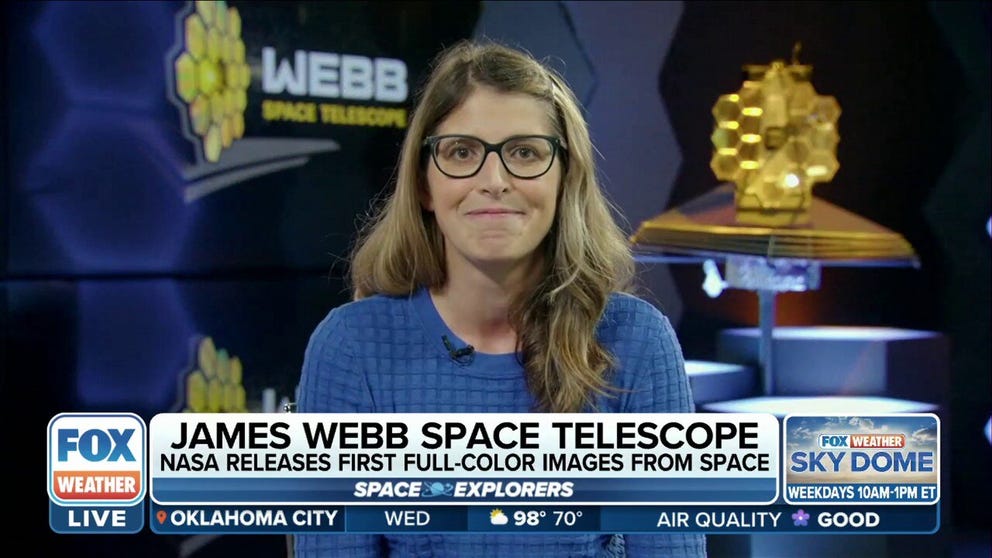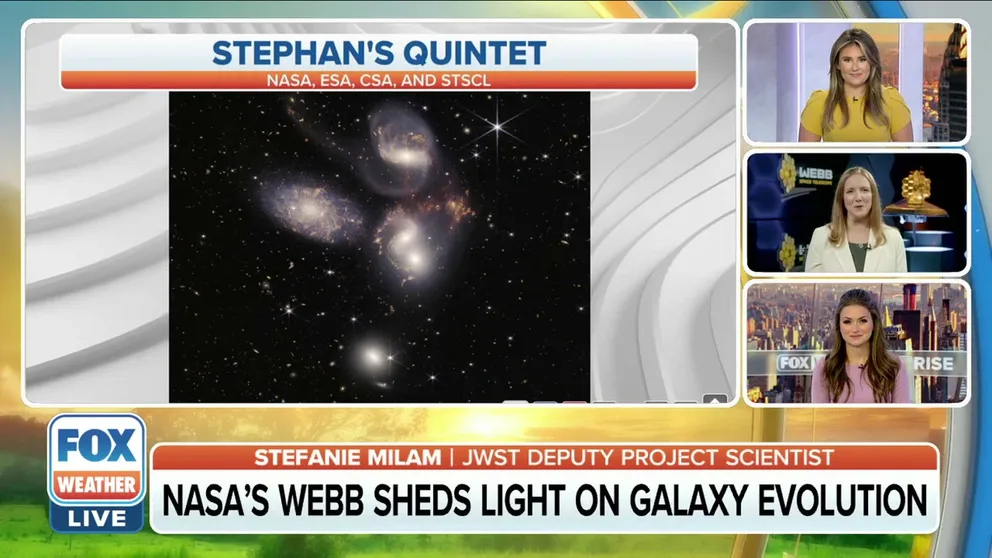James Webb Space Telescope's first images of universe usher in 'new era of astronomy,' scientists say
'I nearly broke my jaw in what I saw,' Webb scientist René Doyon says
'New realm of exploration': Full-color images from NASA telescope shows galaxies colliding
Stefanie Milam, Planetary Scientist at NASA's Goddard Space Flight Center, talks about the excitement of the first full-color images from the James Webb Space Telescope being revealed on Tuesday.
Surprise, tears of joy and pride were just some reactions from astronomers when the first color images from NASA's James Webb Space Telescope were shared with the world, a critical milestone that allowed the observatory to flex its muscles for the first time.
NASA held an image release event at Goddard Space Flight Center in Maryland on Tuesday, complete with cheerleaders holding golden mirrors and welcoming a portion of the 20,000 people who contributed to the telescope.
NASA’s partners on the Webb mission, Space Telescope Science Institute, the Canadian Space Agency and the European Space Agency, also played a role in releasing the first images from the observatory. The result was a party of cosmic proportions as scientists and space enthusiasts worldwide looked at what Webb could do.
JAMES WEBB SPACE TELESCOPE IMAGES WOW BY SHOWING STAR NURSERY, GALAXIES IN A COSMIC DANCE
The released images included a star nursery known as "Cosmic Cliffs," a quintet of galaxies, two dying stars -- including one with a supermassive black hole -- and atmosphere signatures from a hot gaseous exoplanet that we now know has clouds.
NASA Webb science team member Stefanie Milam said these images scratch the surface of JWST's abilities. The Hubble Space Telescope sees in visible optical light, like humans see, whereas Webb sees infrared as the "night vision goggle of the universe," Milam explained.
"We get to see inside dust and in clouds where stars are being born. We get to see how stars are actually dying and how that material is being projected into the vastness of space. We get to see how galaxies are evolving, how they're merging with each other, how black holes are starting to eat all of that material around them," Milam said. "This is just a whole new era of astronomy and astrophysics and even planetary science."
While the rest of the world only saw the images this week, the scientists on Webb’s commissioning team were still in awe after sharing the accomplishment with the public.
James Webb Telescope images are jaw dropping, says NASA NIRSpec scientist
NIRSpec Instrument Scientist, Nora Luetzgendorf, says the infrared telescope has longer wavelengths and allows humans to look into dust clouds to find new stars and planets.
Even before the color images, seeing the first images come back from Webb during commissioning prompted tears of joy from the science team.
'NAILED IT': JAMES WEBB SPACE TELESCOPE'S FIRST IMAGE IS SOMETHING TO CELEBRATE
Milam said she is brought to tears each time she sees the impressive images.
"Every single time they have come across my desk or my computer or even during the viewing this morning, it brought tears and absolute emotion to not only myself, but all of my colleagues that have been working on this project for so long," Milam said.
Webb operations project scientist Jane Rigby said she had a similar reaction to the first time she saw an image from the observatory.
"I had the very emotional reaction of, ‘Oh, my goodness, it works, and it works better than we thought,’" Rigby said, adding other team members in the room were giddy looking at the data.
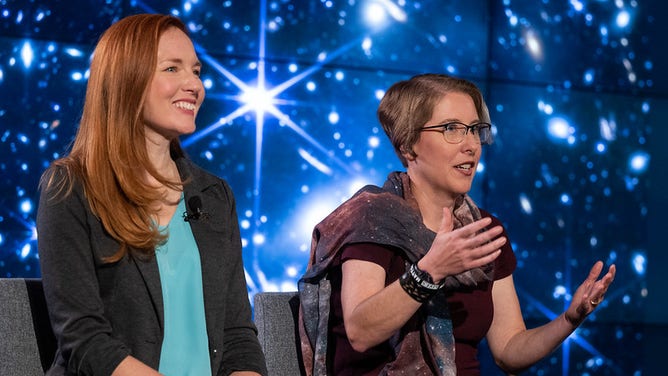
NASA James Webb Space Telescope Operations Project Scientist Jane Rigby, left, answers a question from a member of the media alongside NASA James Webb Space Telescope Deputy Project Scientist for Communications Amber Straughn following the release of the first full-color images from NASA’s James Webb Space Telescope, Tuesday, July 12, 2022, at NASA’s Goddard Space Flight Center. Photo Credit: (NASA/Bill Ingalls)
Canadian principal investigator for two of Webb’s instruments, René Doyon, said seeing data about the exoplanet WASP-96b floored him, even with his knowledge about what the observatory was designed to do.
"I've been working on this project for 20 years. So we should expect what we saw," Doyon said. "But no, several times in the last six months, I nearly broke my jaw in what I saw."
Doyon said he thinks the fellow science community will fill the same.
Webb’s deep-field view of a galaxy cluster known as SMACS 0723 was taken in June, meaning the commissioning team was the first to experience processing Webb's high-resolution images.
WHO WAS JAMES WEBB? THE NAMESAKE BEHIND THE SPACE TELESCOPE
STScI Webb project scientist Klaus Pontoppidan estimated most of the time, data from the telescope would be turned into a final image over several weeks.
"We’re sort of the first science users, like the first people who had to actually take data from the telescope and create a product that you can do science with that is such high quality," Pontoppidan said. "This is still a testament for how powerful this observatory is, that you can get the quality of data that you can turn around for the first time. We're doing this for science, right, in just a few days."
What’s next for Webb: Searching for life and much more
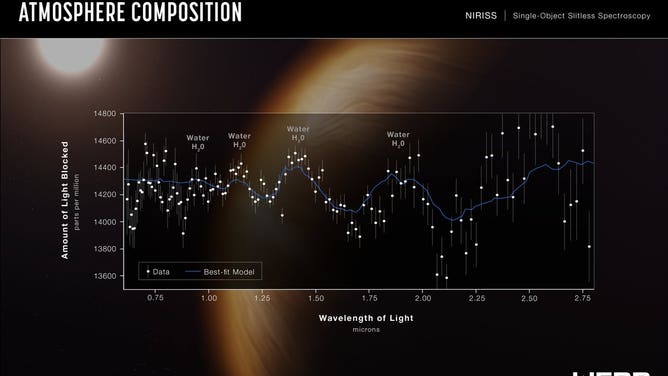
Canada’s instrument NIRISS on Webb reveals the distinct signature of water in the atmosphere of a hot, puffy gas giant exoplanet orbiting a distant Sun-like star. (Image: CSA/NASA/ESA)
New images from JWST will be released weekly on the Space Telescope Science Institute website, including some pictures of our solar system later this week and soon images of worlds way beyond our planetary system.
Webb deputy project scientist for exoplanet science Knicole Colón, with NASA Goddard, said JWST would observe every planet in the TRAPPIST-1 system, looking for possibly habitable planets in the system 40 billion light-years away.
"There are seven planets, and several of those are considered to be in the habitable zone of that star, which means they have the right temperature, that they could have liquid water on their surface," Colón explained. "What Webb is going to do is first check whether they have an atmosphere at all. That's our first step in the process. And then check. Okay, now, if we confirm there's an atmosphere, what can we tell about the composition?"
More than 5,000 exoplanets have been discovered to date, according to NASA.
The science behind the first images from the James Webb Space Telescope
Stefanie Milam, James Webb Space Telescope deputy project scientist, explains the science behind the first images from the James Webb Space Telescope.
Webb will use the Near-Infrared Imager and Slitless Spectrograph (NIRISS) instrument to understand the atmospheres, size and orbit of exoplanets.
Some Webb data released on Tuesday included details about an exoplanet called WASP-96b. The Canadian-built instrument could detect previously hidden details, including the signature of water and evidence of clouds.
While some might feel small looking into one of JWST’s images containing thousands of galaxies in the same space as a grain of sand in the night sky, NASA Astrophysics Division chief scientist Eric Smith said he felt empowered.
"When I see these pictures, they make me feel powerful that a team of people can make this unbelievable instrument to find out things about the universe revealed here and just seeing that pride in the team, but just sort of pride in humanity that when we want to, we can do that," Smith said.
JWST launched on Christmas morning in 2021, and more than six months later the treasure trove of data from the observatory is just beginning to open.
"It’s been out there. We just had to build a telescope to go see what was there. That very similar feeling of maybe people in a broken world managing to do something right and to see some of the majesty that's out there," Rigby said.
The first year of the telescope’s science operations are already planned out and have begun. However, most of Webb’s data will be publicly available. This will inevitably lead to discoveries and many scientific papers in the coming years. Mission managers said JWST has enough fuel to continue operating 1 million miles from Earth for several decades.
